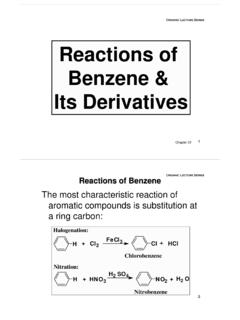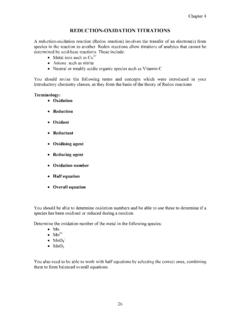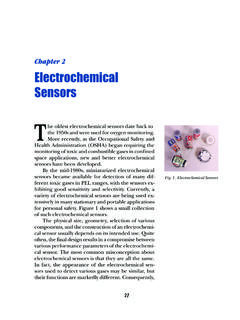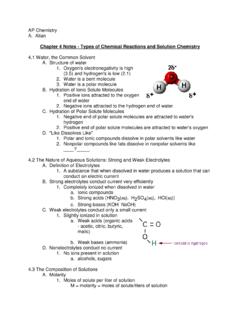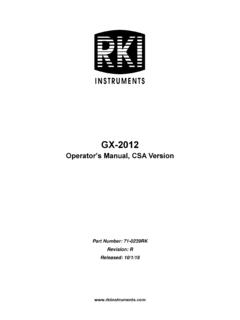Transcription of Acids and Bases - University of Texas at Austin
1 2/25/2016. Acids and Bases chapter 4. 1. Arrhenius Acids and Bases In 1884, Svante Arrhenius proposed these definitions acid : A substance that produces H3O+ ions aqueous solution. base : A substance that produces OH- ions in aqueous solution. this definition of an acid is a slight modification of the original Arrhenius definition, which was that an acid is a substance that produces H+ in aqueous solution. today we know that H+ reacts immediately with a water molecule to give a hydronium ion. H+ + H 2 O( l) H 3 O + ( a q). Hydronium ion 2. 1. 2/25/2016. Br nsted-Lowry Definitions acid : proton donor. base :proton acceptor. 3. Conjugate Acids & Bases Conjugate base : The species formed from an acid when it donates a proton to a base . Conjugate acid : The species formed from a base when it accepts a proton from an acid .
2 acid - base reaction: A proton-transfer reaction. Conjugate acid - base pair: Any pair of molecules or ions that can be interconverted by transfer of a proton. conjugate acid - base pair conjugate acid - base pair HCl( a q) + H2 O( l) Cl - ( a q) + H3 O + ( a q). Hydrogen Water Chloride Hydronium chloride ion ion ( acid ) ( base ) (conjugate (conjugate base of HCl) acid of H 2 O). 4. 2. 2/25/2016. Conjugate Acids & Bases Br nsted-Lowry definitions do not require water as a reactant. Consider the following reaction between acetic acid and ammonia. conjugate acid - base pair conjugate acid - base pair CH 3 COOH + N H3 CH3 COO- + N H4 +. Acetic acid Ammonia Acetate Ammonium ion ion ( acid ) ( base ) (conjugate base (conjugate acid acetic acid ) of ammonia). 5. Acids & Bases Use curved arrows to show the flow of electrons in an acid - base reaction.
3 :O: H :O: H. : : : CH3 -C- O H + :N H CH3 -C- O: - + H- N- H. : H H. Acetic acid Ammonia Acetate ion Ammonium (proton donor) (proton acceptor) ion 6. 3. 2/25/2016. Resonance in Acids Many organic molecules have two or more sites that can act as proton acceptors. In this chapter , discussion is limited to carboxylic Acids , esters, and amides. In these molecules, the favored site of protonation is the one in which the charge is more delocalized. Question: Which oxygen of a carboxylic acid is protonated? + H. O O O. +. CH3 -C- O-H + H 2 SO 4 CH3 -C- O-H or CH3 -C- O-H + HSO4 - H. A B. (protonated (protonated on the on the carbonyl oxygen) hydroxyl oxygen). 7. Electrons As Basic Sites Proton-transfer reactions occur with compounds having electrons, as for example the electrons of carbon- carbon double and triple bonds.
4 The pi electrons of 2-butene, for example, react with HBr by proton transfer to form a new C-H bond. + H. CH 3 -CH = CH -CH3 + H- Br CH 3 -C- C-CH3 Br H H. 2-Butene sec-Butyl cation (a 2 carbocation). 8. 4. 2/25/2016. Electrons As Basic Sites The result is formation of a carbocation, a species in which one of its carbons has only six electrons in its valence shell and carries a charge of +1. + H. CH 3 -CH = CH -CH 3 + H- Br CH 3 -C- C-CH 3 Br H H. 2-Butene sec-Butyl cation (a 2 carbocation). 9. 10. 5. 2/25/2016. H+ H. 11. 12. 6. 2/25/2016. Electrons As Basic Sites Sample Problem: Draw Lewis structures for the two possible carbocations formed by proton transfer from HBr to 2-methyl-2- butene. CH3. CH3 -C=CH-CH 3 + H-Br 2-Methyl-2-buten e 13. Acids & base Strengths The strength of an acid is expressed by an equilibrium constant.
5 The acid dissociation of acetic acid is given by the following equation. O O. - +. CH3 COH + H2 O CH3 CO + H3 O. A cetic acid Water Acetate Hyd roniu m ion ion 14. 7. 2/25/2016. Weak Acids and Bases An equilibrium expression for the dissociation of any uncharged acid , HA, is written as: - +. HA + H2 O A + H3 O. + - Keq = [H3 O ] [A ]. [ HA][ H2 O]. 15. Weak Acids and Bases Water is a solvent and its concentration is a constant equal to approximately mol/L. We can combine these constants to give a new constant, Ka, called an acid dissociation constant. [H3 O+ ][A- ]. K a = Keq[ H2 O] =. [HA]. 16. 8. 2/25/2016. pKa acid Fo rm ula pK a Co nju gate Bas e - Weaker Ethan e CH3 CH 3 51 CH3 CH 2 S tro ng er acid - co nju gate Ethy lene CH2 = CH2 44 CH2 = CH. - base Am mo nia NH3 38 NH2. - Hyd ro gen H2 35 H.
6 - Acety lene HC CH 25 HC C. - Ethan ol CH3 CH 2 OH CH3 CH 2 O. - Water H2 O HO. +. M ethy lamm on ium ion CH3 NH3 CH3 NH2. - 2- Bicarbo nate io n HCO3 CO3. - Phen ol C6 H5 OH C6 H5 O. +. Am mo niu m io n NH4 NH3. - Hyd ro gen su lfid e H2 S HS. - Carbo nic acid H2 CO3 HCO3. - Acetic acid CH3 COOH CH3 COO. - Benzo ic acid C6 H5 COOH C6 H5 COO. - Pho sp ho ric acid H3 PO4 H2 PO4. +. Hyd ro niu m io n H3 O H2 O. - Sulfuric acid H2 SO4 HSO4. - Hyd ro gen ch loride HCl -7 Cl - Weaker Stron ger Hyd ro gen brom ide HBr -8 Br co nju gate - acid Hyd ro gen iod ide HI -9 I base 17. acid - base Equilibria Equilibrium favors reaction of the stronger acid and stronger base to give the weaker acid and weaker base . - CH3 COOH + N H3 CH3 COO + N H4 +. Acetic acid Ammonia Acetate ion Ammonium p Ka (stronger base ) (weaker base ) ion (stronger acid ) p Ka (weaker acid ).
7 Favors the side with the highest pKa ( weaker acid ). 18. 9. 2/25/2016. acid - base Equilibria Consider the reaction between acetic acid and sodium bicarbonate. write the equilibrium as a net ionic equation. omit Na+ because it does not undergo any chemical change in the reaction. O O. - - CH3 COH + HCO3 CH3 CO + H2 CO3. A cetic acid Bicarb on ate ion Acetate ion Carbonic acid pK a pK a (stron ger acid ) (w eak er acid ). Equilibrium lies to the right. Carbonic acid forms, which then decomposes to carbon dioxide and water. 19. Thermochemistry & Mechanisms Reaction mechanism: A step-by-step description of how a chemical reaction occurs. Thermochemistry: The study of the energy of an entire system at each and every instant of a reaction. Reaction coordinate diagram: A graph showing the energy changes that occur during a chemical reaction.
8 Energy is plotted on the vertical axis and reaction progress (time) is plotted along the horizontal axis. 20. 10. 2/25/2016. Thermochemistry & Mechanisms Most chemical reactions occur via collisions. During collisions, the structure of a molecule contorts and flexes. Collisions of higher energy lead to larger distortions in structure. During collisions, the kinetic energy of the reactants is converted to potential energy, which is stored in the chemical structures in the form of structural strains. 21. Thermochemistry & Mechanisms During a collision process that yields a reaction, a transition state ( ) is formed which possesses partially broken and partially formed bonds. Chemists use reaction coordinate diagrams to show the changes in energy for the molecules involved in a chemical reaction. 22. 11.
9 2/25/2016. Thermochemistry & Mechanisms A reaction coordinate diagram for a one step reaction between H-A and B. 23. Thermochemistry & Mechanisms For reactions at constant pressure, the change in Gibbs free energy, G , is used. This kind of energy controls the rates and equilibrium of reactions. The change in Gibbs free energy between reactants and products is related to the equilibrium constant through this equation: G = -RT ln Keq where R = mol and T is the temperature in kelvins. Free energy of activation: The difference in energy between reactants and the transition state. 24. 12. 2/25/2016. Molecular Structure and Acidity The overriding principle in determining the relative acidities of uncharged organic Acids is the stability of the anion, A-, resulting from the loss of a proton. themore stable the anion, the greater the acidity of HA.
10 25. Molecular Structure and Acidity Ways to stabilize anions include having the negative charge: 1. on a more electronegative atom. 2. on a larger atom. 3. delocalized through resonance. 4. delocalized by the inductive effect. 5. in an orbital with more s character. 26. 13. 2/25/2016. Electronegativity 1. Electronegativity of the atom bearing the negative charge Within a period, the greater the electronegativity of the atom bearing the negative charge, the more strongly its electrons are held, the more stable the anion is, and the stronger the acid . 27. Size of the atom 2. Size of the atom bearing the negative charge The larger the atom bearing the charge, the greater its stability.. CH 3 S H + CH 3 O CH 3 S + CH 3 O H. Methanethiol Methoxide Methanethiolate Methanol pKa ion ion pKa 16. (stronger acid ) (stronger base ) (weaker base ) (weaker acid ).
